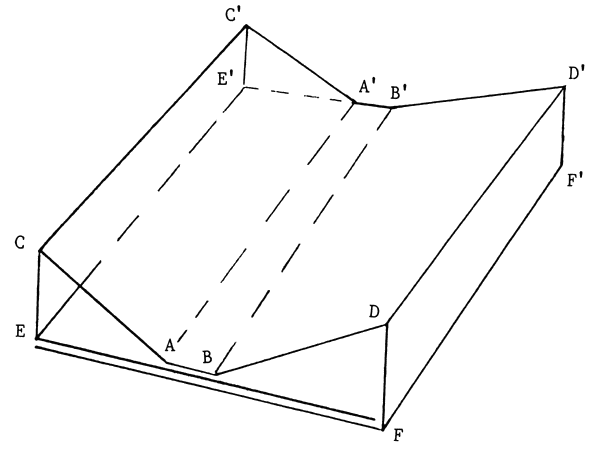

Faced with a need to fabricate book supports on short notice for an exhibit at the New York Academy of Medicine, I experimented with designing them in 5-mil polyester film. We had been making two-piece book cradles of binder's board covered with book cloth which were time-consuming to construct. Since the books for this particular exhibit were all fairly small and light in weight (ranging from 3" to 8" tall and from 1" to 2" thick), I thought of using polyester film. I constructed a book support which consisted of one length of polyester film folded to form the shape of two wedges on a base. As in any exhibit, the degree to which the books could be opened varied and so I naturally wanted to allow each to rest in a safe and comfortable position. The support was designed to accommodate a particular book and the result was that the volume was evenly supported across its boards and spine and rested open at an angle appropriate to that book.
The outcome of the experiment was that in a matter of minutes an exhibit support was fabricated that exactly fit one volume. The beauty of the polyester film structure is that the surface acts as a flexible support which can conform to irregularities in the shape of the book's boards and therefore distributes the weight of the book evenly. Added advantages are that the material used is archivally sound and relatively inexpensive; the time involved in fabrication is minimal. Also, once installed, the support is aesthetically pleasing: the books appear to float in the case. The support does not call attention to itself and the viewer can enjoy looking at the displayed pages without the distraction of an elaborate or cumbersome support System. All that can be seen are some reflections off the polyester film. The support, slightly smaller in height and width than the book resting on top of it, is nearly invisible. I dubbed it the "un-cradle."

As a rough measurement, I cut a rectangle of 5-mil polyester film approximately three times the girth of the book by slightly less than three times the height of the book (the point being to have a support slightly smaller than the book). I then fold the film into thirds, forming a long strip three times the girth of the book by slightly less than the height of the book. At this point, I crease the polyester film ("valley" fold AA') with a bone folder just slightly to the left of the center of the folded strip to mark the spot for the left side of the book's spine. Next, I crease the polyester film one spine's width to the right ("valley" fold BB') for the other side of the spine; now there is an exact place for the spine of the book to rest. The next fold ("Mountain' CC') is made just slightly less than the width of the front board and a corresponding "Mountain' fold is created for the back board (DD').
At this point it is necessary to place the book in the position desired for the exhibit, open to the display pages.
From this I measure the height of the book's foredge above the table and make a corresponding "mountain" fold in the polyester film (EE'). This form the left turn-in for the support's base, a right angle (CEA). The sane process is repeated to form the other right angle (DFB). The two wedges thus formed are not necessarily the same size but they exactly fill the space upon which the book will "float." This completes the folding of the polyester film. I can then place the book in its exhibit position on the nearly completed polyester film support and adjust the base sections to maintain the right angles and establish the finished shape. Since the original polyester film rectangle is three times the girth of the book, the two base sections project beyond the sides of the wedges; the excess is trimmed off neatly on the board shears. I secure the finished shape of the support with double-sided tape (3M #415) at either end of the base (EE' and FF'). If desired, tape could also be applied to the underside of the spine-area of the support to secure it firmly to the base.
The above construction was all that was required for the small books in this particular exhibition. From beginning to end, it took about fifteen minutes to complete a polyester film "un-cradle." When later experimenting with substantially larger, heavier books, I found that me quick modification was all that was necessary to accommodate these as well. I added this step after all of the above had been completed. I cut pieces of 4-ply museum board just a hair less than the height of each of the wedges (CE and DF) by a hair less than the depth of the support (EE' and FF') and inserted these two rectangles into the slots created by the thrice-folded polyester film (CE and DF). These "legs" provided the additional strength required to stabilize the mount when supporting a heavier book. I have successfully supported books up to 10" x 14", 4" thick, and weighing as much as 11 pounds. The addition of the stabilizing board does detract from the airy quality of the polyester film support but one could cover the outside of the board with a plain or decorated paper to give an attractive appearance.
We have used these polyester film book supports in several exhibitions in the Rare Book Room at the New York Academy of Medicine. The supports work well, they are inexpensive and easy to construct, and they can be stored or discarded after use.